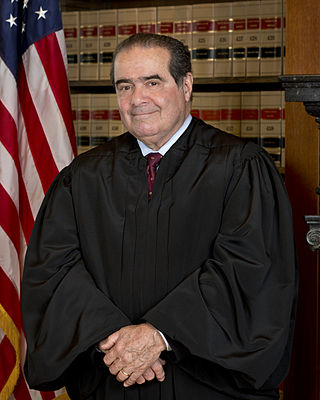
Antonin Gregory Scalia was an American jurist who served as an associate justice of the Supreme Court of the United States from 1986 until his death in 2016. He was described as the intellectual anchor for the originalist and textualist position in the U.S. Supreme Court's conservative wing. For catalyzing an originalist and textualist movement in American law, he has been described as one of the most influential jurists of the twentieth century, and one of the most important justices in the history of the Supreme Court. Scalia was posthumously awarded the Presidential Medal of Freedom in 2018, and the Antonin Scalia Law School at George Mason University was named in his honor.
Cruzan v. Director, Missouri Department of Health, 497 U.S. 261 (1990), was a landmark decision of the Supreme Court of the United States involving a young adult incompetent. The first "right to die" case ever heard by the Court, Cruzan was argued on December 6, 1989, and decided on June 25, 1990. In a 5–4 decision, the Court affirmed the earlier ruling of the Supreme Court of Missouri and ruled in favor of the State of Missouri, finding it was acceptable to require "clear and convincing evidence" of a patient's wishes for removal of life support. A significant outcome of the case was the creation of advance health directives.

The Supreme Court of the United States is the highest court in the federal judiciary of the United States. The procedures of the Court are governed by the U.S. Constitution, various federal statutes, and its own internal rules. Since 1869, the Court has consisted of one chief justice and eight associate justices. Justices are nominated by the president, and with the advice and consent (confirmation) of the U.S. Senate, appointed to the Court by the president. Once appointed, justices have lifetime tenure unless they resign, retire, or are removed from office.

The Roberts Court is the time since 2005 during which the Supreme Court of the United States has been led by John Roberts as Chief Justice. Roberts succeeded William Rehnquist as Chief Justice after Rehnquist's death.
Rapanos v. United States, 547 U.S. 715 (2006), was a United States Supreme Court case challenging federal jurisdiction to regulate isolated wetlands under the Clean Water Act. It was the first major environmental case heard by the newly appointed Chief Justice, John Roberts, and Associate Justice Samuel Alito. The Supreme Court heard the case on February 21, 2006, and issued a decision on June 19, 2006.

The Supreme Court of the United States handed down eight per curiam opinions during its 2006 term, which began October 2, 2006 and concluded September 30, 2007.

The 2015 term of the Supreme Court of the United States began October 5, 2015, and concluded October 2, 2016. The table below illustrates which opinion was filed by each justice in each case and which justices joined each opinion.
Friedrichs v. California Teachers Association, 578 U.S. ___ (2016), is a United States labor law case that came before the Supreme Court of the United States. At issue in the case was whether Abood v. Detroit Board of Education (1977) should be overruled, with public-sector "agency shop" arrangements invalidated under the First Amendment, and whether it violates the First Amendment to require that public employees affirmatively object to subsidizing nonchargeable speech by public-sector unions, rather than requiring employees to consent affirmatively to subsidizing such speech. Specifically, the case concerned public sector collective bargaining by the California Teachers Association, an affiliate of the National Education Association.
Kansas v. Carr, 577 U.S. 108 (2016), was a case in which the Supreme Court of the United States clarified several procedures for sentencing defendants in capital cases. Specifically, the Court held that judges are not required to affirmatively instruct juries about the burden of proof for establishing mitigating evidence, and that joint trials of capital defendants "are often preferable when the joined defendants’ criminal conduct arises out of a single chain of events". This case included the last majority opinion written by Justice Antonin Scalia before his death in February 2016.

With the advice and consent of the United States Senate, the president of the United States appoints the members of the Supreme Court of the United States, which is the highest court of the federal judiciary of the United States. Following his victory in the 2016 presidential election, Republican Donald Trump took office as president on January 20, 2017, and faced an immediate vacancy on the Supreme Court due to the February 2016 death of Associate Justice Antonin Scalia.

The 2016 term of the Supreme Court of the United States began October 3, 2016, and concluded October 1, 2017. The table below illustrates which opinion was filed by each justice in each case and which justices joined each opinion.
Sessions v. Dimaya, 584 U.S. 148 (2018), was a United States Supreme Court case in which the Court held that 18 U.S.C. § 16(b), a statute defining certain "aggravated felonies" for immigration purposes, is unconstitutionally vague. The Immigration and Nationality Act (INA) classifies some categories of crimes as "aggravated felonies", and immigrants convicted of those crimes, including those legally present in the United States, are almost certain to be deported. Those categories include "crimes of violence", which are defined by the "elements clause" and the "residual clause". The Court struck down the "residual clause", which classified every felony that, "by its nature, involves a substantial risk" of "physical force against the person or property" as an aggravated felony.




